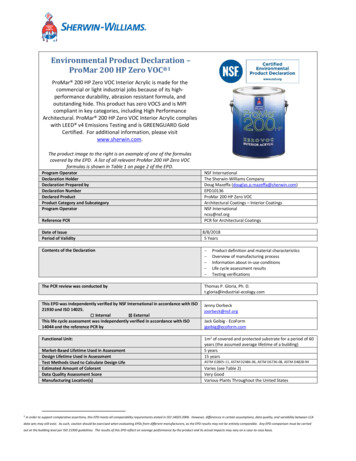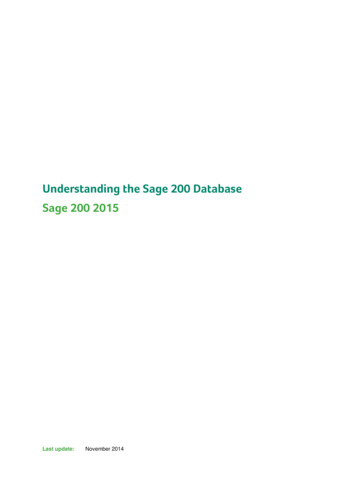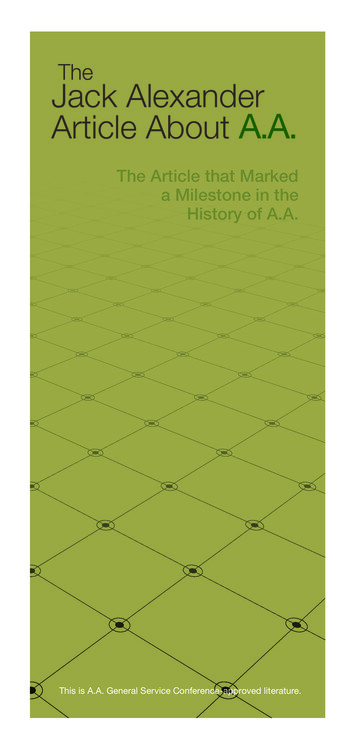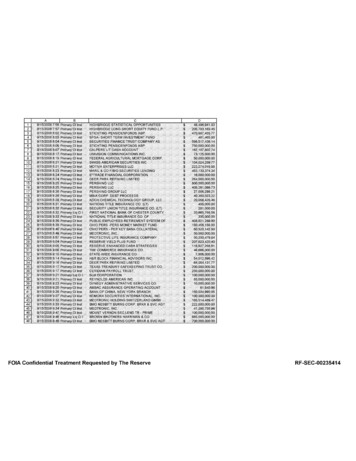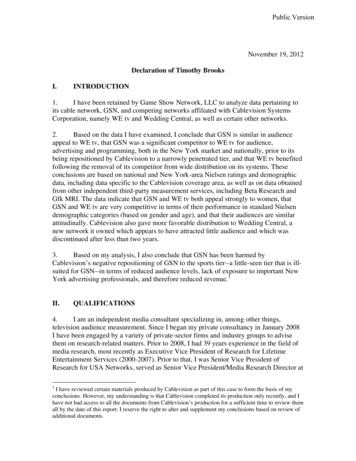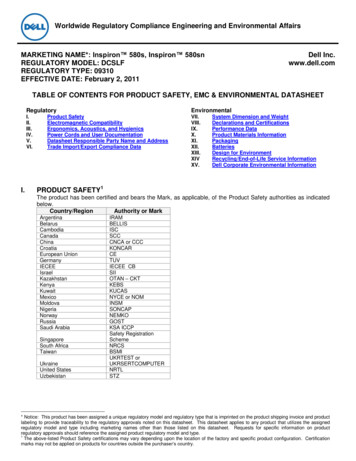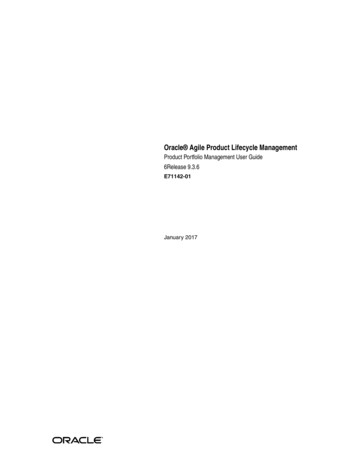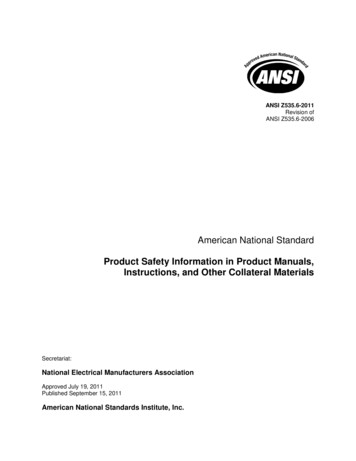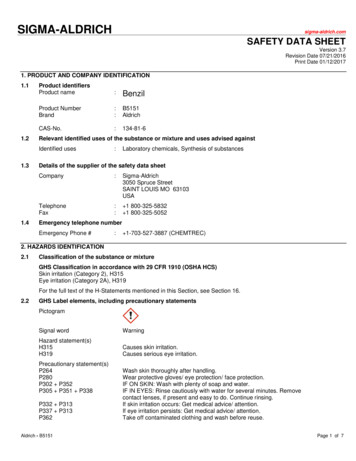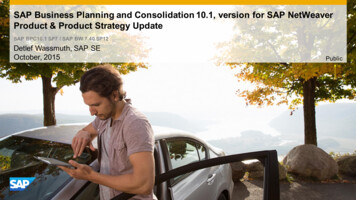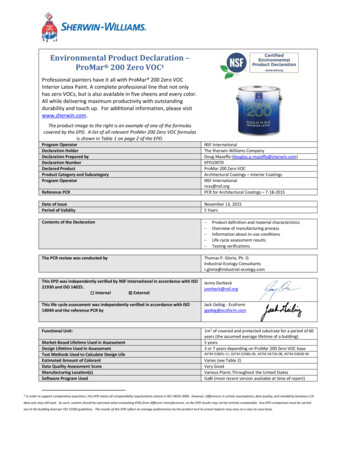
Transcription
Environmental Product Declaration –ProMar 200 Zero VOC1Professional painters have it all with ProMar 200 Zero VOCInterior Latex Paint. A complete professional line that not onlyhas zero VOCs, but is also available in five sheens and every color.All while delivering maximum productivity with outstandingdurability and touch up. For additional information, please visitwww.sherwin.com.The product image to the right is an example of one of the formulascovered by the EPD. A list of all relevant ProMar 200 Zero VOC formulasis shown in Table 1 on page 2 of the EPD.Program OperatorDeclaration HolderDeclaration Prepared byDeclaration NumberDeclared ProductProduct Category and SubcategoryProgram OperatorReference PCRNSF InternationalThe Sherwin-Williams CompanyDoug Mazeffa (douglas.p.mazeffa@sherwin.com)EPD10070ProMar 200 Zero VOCArchitectural Coatings – Interior CoatingsNSF Internationalncss@nsf.orgPCR for Architectural Coatings – 7-18-2015Date of IssuePeriod of ValidityNovember 13, 20155 YearsContents of the Declaration The PCR review was conducted byThomas P. Gloria, Ph. D.Industrial Ecology Consultantst.gloria@industrial-ecology.comThis EPD was independently verified by NSF International in accordance with ISO21930 and ISO 14025.InternalExternalJenny Oorbeckjoorbeck@nsf.orgThis life cycle assessment was independently verified in accordance with ISO14044 and the reference PCR byJack Geibig - EcoFormjgeibig@ecoform.comFunctional Unit:1m2 of covered and protected substrate for a period of 60years (the assumed average lifetime of a building)5 years3 or 7 years depending on ProMar 200 Zero VOC baseMarket-Based Lifetime Used in AssessmentDesign Lifetime Used in AssessmentTest Methods Used to Calculate Design LifeEstimated Amount of ColorantData Quality Assessment ScoreManufacturing Location(s)Software Program Used1Product definition and material characteristicsOverview of manufacturing processInformation about in-use conditionsLife cycle assessment resultsTesting verificationsASTM D2805-11, ASTM D2486-06, ASTM D6736-08, ASTM D4828-94Varies (see Table 2)Very GoodVarious Plants Throughout the United StatesGaBi (most recent version available at time of report)In order to support comparative assertions, this EPD meets all comparability requirements stated in ISO 14025:2006. However, differences in certain assumptions, data quality, and variability between LCAdata sets may still exist. As such, caution should be exercised when evaluating EPDs from different manufacturers, as the EPD results may not be entirely comparable. Any EPD comparison must be carriedout at the building level per ISO 21930 guidelines. The results of this EPD reflect an average performance by the product and its actual impacts may vary on a case-to-case basis.
Product Definition:ProMar 200 Zero VOC is a family of interior architectural coatings manufactured by The SherwinWilliams Company, headquartered in Cleveland, Ohio. ProMar 200 Zero VOC is manufactured in anumber of Sherwin-Williams facilities across the United States. These coatings are designed to coverand protect architectural surfaces such as walls and ceilings. For information about specific products,please visit www.sherwin.com.Product Classification and Description:The ProMar 200 Zero VOC products listed below are included within this assessment. The primarydifferences between these products are gloss levels (sheen) and base types. For information on otherattributes of each of the specific formulations, please visit www.sherwin.com.Table 1. List of ProMar 200 Zero VOC Formulas Assessed by LCA Model and Report.Product NumberSheenBase Type as Defined by PCRB20W2653Eg-ShelDeep BaseB30W2653FlatDeep BaseB20T2654Eg-ShelUltra Deep BaseB20W12651Eg-ShelTintable WhiteB30W2651FlatLight BaseB31W2651Semi-GlossDeep BaseB20W2651Eg-ShelLight BaseB28W2600PrimerPrimerB20W2650Eg-ShelLight BaseB24W2651Semi-GlossPastel BaseB21W12651GlossDeep BaseB41W2651Low-GlossMid BaseB30W12651FlatTintable White
Under the Product Category Rule (PCR) for Architectural Coatings, ProMar 200 Zero VOC falls under thefollowing heading: “a decorative or protective paint or coating that is formulated for interior or exteriorarchitectural substrates including, but not limited to: drywall, stucco, wood, metal, concrete,and masonry.”Architectural coatings are manufactured in a way similar to other paint and coating products. Rawmaterials are manually added in appropriate quantities into a high-speed disperser which are mixed.The product is then moved via compressed air or gravity and filled into containers and transported tothe distribution center and finally to the point of sale. A customer travels to the store to purchase theproduct and transports the coating to the site where it is applied. The applied coating adheres to thesubstrate where it remains until the substrate is disposed. Any unused coating will be disposed as well.Because the functional unit mandates a 60 year product life, multiple repaints were necessary and wereaccounted for by the LCA models.The typical composition of an interior ProMar 200 Zero VOC coating is shown by % weight below. Water (35%-60%)Resin (7%-30%)Extender Pigments (5%-30%)Titanium Dioxide [CAS # 13463-97-7] (0-19%)Additives (1%-5%)Cristobalite [CAS # 14464-46-1] (0-0.2%)Other than titanium dioxide and cristobalite, there are no additional ingredients present which, withinthe current knowledge of the supplier and in the concentrations applicable, are classified as hazardousto health or the environment and hence require reporting. For additional information about producthazards, please refer to the Safety Data Sheet for the specific ProMar 200 Zero VOC formula available onwww.sherwin.com.About Sherwin-Williams:For more than 149 years, Sherwin-Williams has provided contractors, builders, property managers,architects and designers with the trusted products they need to build their business and satisfycustomers. ProMar 200 Zero VOC Interior Latex is just one more way we bring you industry-leading painttechnology — innovation you can pass on to your customers. Plus, with more than 4,000 stores and2,400 sales representatives across North America, personal service and expert advice is always availablenear jobsites. Find out more about ProMar 200 Zero VOC at your nearest Sherwin-Williams store or tohave a sales representative contact you, call 800-524-5979.
Definitions:Acronyms & Abbreviated Terms: ACA: American Coating AssociationASTM: A standards development organization that serves as an open forum for thedevelopment of international standards. ASTM methods are industry-recognized and approvedtest methodologies for demonstrating the durability of an architectural coating in the UnitedStates.ecoinvent: a life cycle database that contains international industrial life cycle inventory data onenergy supply, resource extraction, material supply, chemicals, metals, agriculture, wastemanagement services, and transport services.EPA WARM model: Unite States Environmental Protection Agency Waste Reduction Model.EPD: Environmental Product Declaration. EPDs are form of as Type III environmentaldeclarations under ISO 14025. They are the summary document of data collected in the LCA asspecified by a relevant PCR. EPDs can enable comparison between products if the underlyingstudies and assumptions are similar.GaBi: Created by PE INTERNATIONAL GaBi Databases are LCA databases that contain ready-touse Life Cycle Inventory profiles.LCA: Life Cycle Assessment or Analysis. A technique to assess environmental impacts associatedwith all the stages of a product's life from cradle to grave (i.e., from raw material extractionthrough materials processing, manufacture, distribution, use, repair and maintenance, anddisposal or recycling).NCSS: NSF International’s National Center for Sustainability StandardsPCR: Product Category Rule. A PCR defines the rules and requirements for creating EPDs of acertain product category.TRACI: Tool for the Reduction and Assessment of Chemical and Other Environmental Impacts.Terminology: Architectural coating: a coating recommended for field application to stationary structures ortheir appurtenances at the site of installation, to portable buildings, to pavements, or to curbs.For purposes of this PCR an ‘architectural coating’ does not include adhesives and coatings forshop applications or original equipment manufacturing, nor does it include coatings solely forapplication to non-stationary structures, such as airplanes, ships, boats, and railcars. Please seethe product category requirements in Section 1.1 of the PCR.Biologic growth or bio deterioration: any undesirable change in material properties broughtabout by the activities of microorganisms.Blistering: the formation of dome shaped hollow projections in paints or varnish films resultingfrom the local loss of adhesion and lifting of the film from the surface or coating.Burnish resistance: the resistance of a coating to an increase in gloss or sheen due to polishingor rubbing.Design life: The estimated lifetime of a coating based solely on its hiding and performancecharacteristics determined by results in certain ASTM durability tests.
Durability: the degree to which coatings can withstand the destructive effect of the conditionsto which they are subjected and how long they retain an acceptable appearance and continue toprotect the substrate.Erosion: the wearing away of the top coating of a painted surface e.g., by chalking, or by theabrasive action of windborne particles of grit, which may result in exposure of the underlyingsurface. The degree of resistance is dependent on the amount of coating retained.Flaking/Peeling: the phenomenon manifested in paint films by the actual detachment of piecesof the film itself either from its substrate or from paint previously applied. Peeling can beconsidered as an aggravated form of flaking. It is frequently due to the collection of moisturebeneath the film.Gloss: a value of specular reflection which is often used to categorize certain types of paints.Intermediate processing: the conversion of raw materials to intermediates (e.g. titaniumdioxide ore into titanium dioxide pigment, etc.).Market-based life: The estimated lifetime of a coating based off the actual use pattern of theproduct type. In this instance, a repaint may occur before the coating fails.Pigment: the material(s) that give a coating its color.Primary materials: resources extracted from nature. Examples include titanium dioxide ore,crude oil, etc. that are used to create basic materials used in the production of architecturalcoatings (e.g., titanium dioxide).Resin/Binder: acts as the glue or adhesive to adhere the coating to the substrate.Scrubbability or scrub resistance: the ability of a coating to resist being worn away or tomaintain its original appearance when rubbed repetitively with an abrasive material.Secondary materials: recovered, reclaimed, or recycled content that is used to create basicmaterials to be used in the production of architectural coatings.Washability: the ease with which the dirt can be removed from a paint surface by washing; alsorefers to the ability of the coating to withstand washing without removal or substantial damage.
Underlying Life Cycle Assessment Methodology:Functional Unit:Per the reference PCR, the functional unit for the study was covering and protecting 1m2 of substrate fora period of 60 years (the assumed lifetime of a building). The product has no additional functionalitiesbeyond what is stated by the functional unit.In the reference PCR, product life for interior architectural coatings was calculated both in terms of atypical market life (5 years) and a technical life (either 3,7, or 15 years depending on performance incertain durability tests/methodologies prescribed in the reference PCR). In order to determine thedesign life of the ProMar 200 Zero VOC formulas, the following durability test methodologies (whichwere stated in the reference PCR) were utilized: ASTM D2805-11 – Opacity (if relevant)ASTM D2486-06(2012)e1 – Scrub ResistanceASTM D6736-08(2013) – BurnishASTM D4828-94(2012)e1 - WashabilityBased on the durability test results, the appropriate quality levels and coating quantities were derivedfor each ProMar 200 Zero VOC formula. If testing results were unavailable for a formula, then it wasassumed to be of ‘low’ quality. This is consistent with the reference PCR.Quality Level2Corresponding Technical Lifetime(years)Market Lifetime (years)Total Quantity Needed usingDesign-Based Life (kg)3Total Quantity Needed usingMarket-Based Life (kg) 4Tint Needed Market (grams)Tint Needed Design 845.707.629.9213.6710.289.92024.81625723See reference PCR for background on quality levels for technical performance.Value includes 10% over-purchase stipulated by reference PCR.4Value includes 10% over-purchase stipulated by reference Product FormulaB30W02653Table 2. Formula Lifetimes and Quantity of Coating Needed to Satisfy Functional Unit
Tinting:As stated in the reference PCR, the tint/colorant inventory was taken from thinkstep carbon blackpigment data in the appropriate quantity specified by the type of coating base for that ProMar 200 ZeroVOC formula. The amount of colorant needed for each formula is shown in Table 2 above.The impact of the tint is included in the overall LCIA results, but is not reported individually since it is nota differentiator between formulas or the eventual EPDs. It should be noted that ProMar formulaB28W02600 does not accept a tint because it is a primer coating.Allocation Rules:In accordance with the reference PCR, allocation was avoided whenever possible, however if allocationcould not be avoided, the following hierarchy of allocation methods was utilized: Mass, or other biophysical relationship; and Economic value.In the LCA models, mass allocation was ONLY used during packaging and end of life-stages.Treatment of Biogenic Carbon:In accordance with the reference PCR, global warming values were calculated and presented bothincluding and excluding biogenic carbon.
System Boundary:This LCA included all relevant steps in the coating manufacturing process as described by the referencePCR. The system boundary began with the extraction of raw materials to be used in the ProMar 200Zero VOC coating and its formulas are manufactured in a way similar to other architectural paint andcoating products. The raw materials are manually added in appropriate quantities into a high-speeddisperser which are mixed. The product is then moved via compressed air or gravity and filled intocontainers and shipped to a distribution center and then to the point of sale. A customer travels to thestore to purchase the product and transports the coating to the site where it is applied. The appliedcoating adheres to the substrate where it remains until the substrate is disposed. Any unused coatingwill be disposed by the customer as well. Because the functional unit mandates a 60 year product life,multiple repaints were necessary and were accounted for by the LCA models. The system boundaryends with the end-of-life stage. This can be seen in Figure 1, below.As described in the reference PCR, the following items were excluded from the assessment and theywere expected to not substantially affect the results. personnel impacts; research and development activities; business travel; any secondary packaging (pallets, for example); all point of sale infrastructure; and the coating applicator.
Figure 1. Diagram of System Boundary for the EPD.Cut-Off Rules:The cut-off rules prescribed by the reference PCR required a minimum of 95% of the total mass, energy,and environmental relevance be captured by the LCA models. All formulas were modeled to at least99.5% of their material content by weight. No significant flows were excluded from the LCA models andthe 5% threshold prescribed by the PCR was not exceeded.
Data Sources & Quality:When primary data was unavailable, data was taken from either thinkstep, ecoinvent, or CEPE’s coatingindustry life cycle inventory. The data from thinkstep and ecoinvent are widely accepted by the LCAcommunity and the CEPE database has been built using those databases as a foundation. A briefdescription of these databases is below:Table 3. Overview of Databases used in LCA Models.DatabaseCommentsSherwin-WilliamsPrimary source data taken as an average monthly value over a 12month average of 2014 relevant facilities operation metrics.thinkstep/GaBiDB Version 6.110ecoinventVersion 3.1 – Most recent version available in GaBi.CEPE LCIMost recent version of industry LCI. Last revised August 14, 2014.Made up of refined data from thinkstep and ecoinvent so that it ismore representative of coating manufacturing. Primarily limited toEU data, although some processes are global.Precision and Completeness:Annual averages from the 2014 calendar year of primary data was used for all gate-gate processes andthe most representative inventories were selected for all processes outside of Sherwin-Williams’ directoperational control. Secondary data was primarily drawn from the most recent GaBi and ecoinventdatabases and CEPE’s 2014 coating life cycle inventory. All of these databases were assessed in terms ofoverall completeness.Assumptions relating to application and disposal were conformant with the reference PCR. All data usedin the LCA models was less than five years old. Pigment data was taken from ecoinvent v3.1 and resindata was taken from primary sources and GaBi databases.Consistency and Reproducibility:In order to ensure consistency, primary source data was used for all gate-to-gate processes in coatingmanufacturing. All other secondary data were applied consistently and any modifications to thedatabases were documented in the LCA Report.Reproducibility is possible using the LCIs documented in the LCA Report.Temporal Coverage:Primary data was collected from the manufacturing facilities from the 2014 calendar year. Secondarydata reflected the most up-do-date versions of the LCA databases mentioned above.
Geographic Coverage:ProMar 200 Zero VOC is manufactured by the Sherwin-Williams Company entirely within the UnitedStates. Given that the facilities making ProMar 200 Zero VOC are spread across the United States, theaverage US grid mix was used in the LCA models. ProMar 200 Zero VOC products are purchased, used,and the unused portions are disposed by the customer throughout the US as well.
Life Cycle Impact Assessment:The purpose of the Life Cycle Impact Assessment (LCIA) is to show the link between the life cycleinventory results and potential environmental impacts. As such, these results are classified andcharacterized into several impact categories which are listed and described below. The TRACI 2.1method was used and the LCIA results are formatted to be conformant with the PCR, which was basedon ISO 21930. The TRACI method is widely accepted for use in the US and was developed by the US EPA.Table 4. Overview of Impact Categories5Overview of LCA Impact CategoriesImpact CategoryDescription of Impact CategoryName“Global warming is an average increase in the temperature of the atmosphere near the Earth’s surface and inGlobal Warmingthe troposphere, which can contribute to changes in global climate patterns. Global warming can occur from aPotentialvariety of causes, both natural and human induced. In common usage, “global warming” often refers to thewarming that can occur as a result of increased emissions of greenhouse gases from human activities” (USEnvironmental Protection Agency 2008b
ProMar 200 Zero VOC is a family of interior architectural coatings manufactured by The Sherwin-Williams Company, headquartered in Cleveland, Ohio. ProMar 200 Zero VOC is manufactured in a number of Sherwin-Williams facilities across the United States. These coatings are designed to cover and protect architectural surfaces such as walls and .File Size: 453KB
